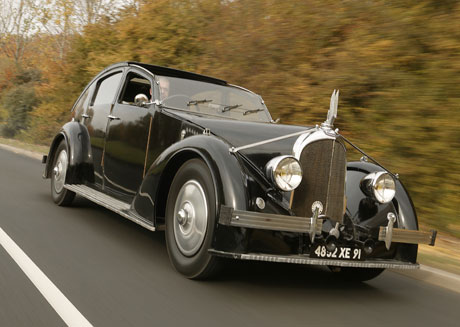SCM Analysis
Detailing
| Vehicle: | 1935 Avions Voisin C25 Aerodyne |
| Original List Price: | $90,752 |
| Tune Up Cost: | $1,000 |
| Chassis Number Location: | Tag on right side of firewall |
| Engine Number Location: | On chassis tag, and on lower right side of block |
| Club Info: | 1936 Bugatti Type 57 Galibier, 1935 Alfa Romeo 6C 2300 Berlina, 1935 Hispano-Suiza K6 |
| Investment Grade: | A |
This car sold for $725,408, including buyer’s premium, at the Artcurial auction in Paris, France, on February 14, 2010.
Gabriel Voisin’s vision produced some of the most remarkable vehicles ever made. Instantly recognizable, they projected a truly futuristic vision, at a time in the auto industry when pure innovation had largely given way to homogenization and refinement, especially among manufacturers of luxury cars. The iconoclastic “aerodynamic” designs, a “form follows function” approach to details, and sleeve-valve engines set them far apart from their competition. Voisin started as an airplane builder before WWI-hence the name of the company, “Avions Voisin,” or “Voisin Airplanes”-and moved into automobiles in 1919. With his singular focus, commanding presence, and sheer will to succeed, he has earned his place as an automotive genius alongside Ford, Porsche, and Ferrari. Losing his firm as the Depression took hold in 1931, he sued to get it back from the receivers by 1933.
It’s not surprising that one of his friends was famed Swiss-born architect Le Corbusier, one of the pioneering modernists. Voisin sponsored Le Corbusier’s 1925 grand scheme to transform half of Paris, which was named the “Plan Voisin” in his honor. In many photographs of the architect’s built projects, Le Corbusier’s own personal Voisin was posed in front, the automotive equivalent of the latest thinking in design for modern living.
Voisin’s benchmark
The C25 Aérodyne is arguably the signature model of the Voisin marque, the visual embodiment of advanced thought. Not only was Voisin consumed with streamlining, an obvious concern of a former airplane builder, but he also embraced the Knight sleeve-valve engine as the ultimate in smooth power delivery. Voisin stuck with the licensed engines long after many had abandoned them for cheaper, more traditional powerplants. Most of the wealthy clientele who could afford a C25 probably didn’t care much about what was under the hood as long as it moved the chassis and the fancy bodywork they’d purchased at a good clip.
As an aside, it is instructive to put the original prices mentioned in the description into modern equivalents: In 2009 dollars, the Citroën Traction sold for $22,688, the Bugatti Type 57 Galibier for $72,252, and the Voisin Aérodyne for a substantial $90,752. This was, of course, in the midst of a worldwide Depression, and for a car that was unconventional, to put it mildly. There’s little surprise that only seven were built, but it’s a wonderful thing that this one survived as it did.
Voisins in general have a mixed record at auction, where their individualist charms may not connect with a wider audience. They’re best sold by hand to those who get their unique charm. That being said, some have done very well indeed. Bonhams quite memorably offered seven Avions Voisin cars from a single French collection and sold four of them for a combined $1.28 million at its 2008 Carmel Valley, California, sale. A “barn find” C25 Clairière was sold by Artcurial in February 2006 for $126,760. Gooding & Company sold the same car, chassis 50017, now running, for $330k at Pebble Beach in August 2007, and it changed hands again at the 2009 Gooding Scottsdale auction at the same $330,000.
A fully restored Aérodyne found a new owner at the Artcurial Paris sale in February 2008 for an almost identical price as this car, $757,178. Taking into account the relative 7% “recovery” of the dollar against the euro in 2010 vs. 2008, the restoration delivered a 10% premium over the original.
Shabby chic
SCM’s man on the scene, Jérôme Hardy, opined that our subject car was both “100% original and 100% shabby.” It was clear the Voisin had evaded modification or restoration and apparently ran well. However, it was equally obvious little had been done over the decades to actually preserve the paint, bright trim, or upholstery, all of which are in very worn, if not desperate, condition. Cars such as this delicately walk the tightrope between “barn find” and “preservation,” the former good for contemplation prior to a full restoration and the latter the most desired of collector cars.
The result achieved for this C25 Aérodyne proves the continuing strength of the unrestored market. Of course, it is also not surprising given the rarity of this car, said to be one of five extant and an iconic high point of the art of Gabriel Voisin. So let’s call this car fairly bought and sold in the current market.
Whether the new and future owners will be able to resist the urge to restore remains the question.
